A Bit of History
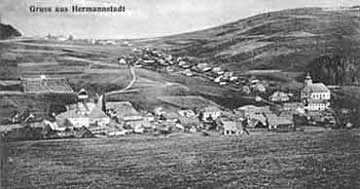

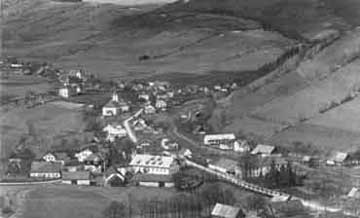
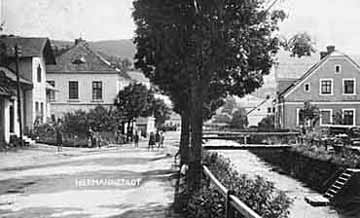
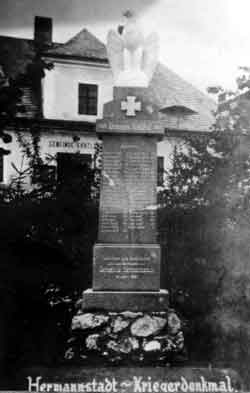
The original German village name Hermannstadt means Heřman's town. The proper name Herman originates in central upper German "hareman, herman" and it means a man bound to a duty in an army. The current Czech form of the name was created in 1924 by suffix "ovice".
In the remote past, the wide Heřmanovice valley lay in the Moravian-Silesian boundary forest called Preseka. It was crossed by a long merchant path running from Olomouc through Bruntál, Vrbno p. Pradědem, along the stream Černá Opava to Zlaté Hory and Nisa. One of its sections went through Horní Údolí and another one through Heřmanovice. In the 13th - 14th centuries, several fortifications near to each other grew next to the merchant path. They were: Castle Quingburg and fortification Drakov in the cadastre of Heřmanovice, castles Koberštejn and Edlštejn and relatively small castles Freudenštejn, Rabenštejn, Weisenštejn and Fürstenwalde. Czech sovereigns of Přemysl lineage, knights of Opava and bishops of Vratislav were interested in colonising this part of Hrubý Jeseník, at that time basically houseless. The reason for their interest, which sometimes even led to tenancy quarrels, undoubtedly lay in gold fields. That was also why the area around Zlaté Hory, which is at the unclear border of two state units, often changed its owner.
It was together with mining colonisation at the turn of the 13th and 14th century that Heřmanovice, at the beginning part of the dominion of Zlaté Hory, was founded. However, no written record was preserved. The first record of the village is in a document from 8th of July 1339 in Olomouc. By the document, the prince of Opava concedes the Castle Edelštejn, Zlaté Hory, Heřmanovice, village Arnoltovice (today in Poland) with gold mines and patronages to the Czech king Jan Lucemburský (John Luxemburg) for sake of peace ("...oppidum Zuckmantel cum Hermanstad oppido et Arnoldsdorff villa et cum castro Edelstein…"). Zuckmantel and Hermanstad mentioned in the document were not towns but market villages. In 1455 the prince Bolek gave to Zuckmantel a right by which Heřmanovice lying near Zuckmantel ceased to be a market village. Later Heřmanovice passed to the Opavian dominion, to the possession of the bishopric of Vratislav and it became part of the principality of Nisa. It belonged to the bishopric dependency till 1848.
The only witness of the village beginning that was maintained till recent past was a medieval stronghold situated near the Chapel St. Jeroným. The small fortification consisting of a slightly elevated mound was surrounded by a moat and a bank. The central plateau was almost square with sides 16 - 17 m long. An iron sword, metal chains and numerous collections of medieval utility pottery had been found before the stronghold was devoured by the limestone quarry.
The main heyday of the gold mines, and not only of them, is ascribed to bishops Jan Thurzo (1506-20), Jakub from Salza (1520-39) and Baltazar from Promnice (1539-62). It was at the time of the second inner colonisation of the Jeseníky area when many villages were founded or restored. From the beginning of the 16th century the bishopric tried to conduct all the kinds of productions and to raise the profit by founding new enterprises. Thus in 1552 the bishop Baltazar from Promnice charged a burgher of Vratislav, Hans Karlina, to produce ore for an iron-mill that Karlina himself had built. He was free of all taxes for two years but later he had to pay 15 Silesian talers per year. The settlement that grew around the iron-mill was given a name Vrbice (Vorwitz). Because Karlin had invested a lot of money into the iron-mill, the bishop allowed him in 1559 to build a second iron-mill and a lumber-mill and charged him to make bar into tan. This was related to a right to lumber needed amounts of wood from bishopric forests. Thus in the middle of the 16th century, the village was an important centre of iron production. After overcoming the consequences of the Thirty Years’ War, local iron enterprises worked almost till the end of the 17th century.
Even this region - the region of Jeseník, of Nisa and Zlaté Hory - was affected by withcraft trials in twenties till eighties of the 17th century. Victims were not few because the mining district commissioner in Zlaté Hory, living in Heřmanovice at that time, demanded after 1640 a kiln to be built for burning of witches according to the example of Nisa where such a kiln had already existed. His demand was refused thanks to the resistance of Zlaté Hory that claimed its law for capital punishment. Councillors defended the cognizance not because of the town's sake but out of their cupidity as the witch executions provided a very profitable business. It is estimated that 85 people were executed in Zlaté Hory, some of them must have been inhabitants of Heřmanovice. Victims were mostly women from rich families but also children. An infamous native of Zlaté Hory, Jindřich František Bobling, participated in the trials as an assessor.
In 1752 municipal administration issued a decree by which it cancelled some freedoms in Heřmanovice and Zlaté Hory, including the freedom from taxes and contributions. The village lost its status of a mining village and after long controversies with the suzerain it had to come to terms with 11 kinds of different duties.
On the basis of a register written for the purpose of taxes in 1620s at the emperor Karel VI.' command, we know that the farms of Heřmanovice, the reeve's office included, owned 362 cows, 63 goats, and one pig and that there were two mills in the village. The handicraft tax was paid to the reeve by a butcher, a baker, 4 shoemakers and 3 smiths; rent was paid by 14 gardeners and 2 taverners.
Despite the hard condition, farming was an important source of livelihood for local inhabitants. On the rocky fields they grew oat, rye, barley, flax, clover and potatoes, and provender on meadows for numerous cattle (75 horses, 296 cows and several goats). At the beginning of the 19th century there were 4 mills, 3 lime furnaces, a lumber-mill and several bleacheries.
As mining went trough a time of decay, local production had to focus on something else - flax industry. Zlaté Hory in particular became an important centre of the linen and line trade together with Nisa, Prudnik and Vratislav. It was around Heřmanovice area that the best quality flax thrived. Especially bleaching for which there were good conditions (woods to produce the wooden ash, clean water) developed. In 1788 there were 11 bleacheries around Heřmanovice. Most of the families span at their homes throughout the all year or only in winter.
The disadvantage of the only occupation showed itself in 1840s when the domestic spinning came to a decay. Josef Münzberg's textile factory in Zlaté Hory and also other loom workrooms had to dismiss a lot of their weavers who became jobless and in all the Zlaté Hory area a period of poverty started. Out of misery people began to cut trees in episcopal woods, and after chipping the trees they smuggled them to Prussia. In 1849 the bishop called a regiment of 62 soldiers (which stayed there till August) to stop the embezzlers.
Jan Höniger, a native of Heřmanovice, took the last attempt at reviving the mineral mining in the ore area of Zlaté Hory. In 1844 he asked the mining office in Kutná Hora for a concession to mine in ten places on Příčný vrch. He extracted about 400 grams of gold per year which, without the expected state support, was not enough to cover expenditure.
The Revolution in 1848 affected this region too - the lordships were abolished and the village became part of a new soke Cukmantl that was part of the political region Jeseník, presided by regional district commissioner. The first reeve of the village was Franz Kröner. In 1869 there was a small change in the political administration when the soke Vrbno pod Pradědem came into existence and village Mnichov with the settlement Železná was incorporated into it.
Village post office started to work on 16th March 1869 and it was connected with the surrounding areas by a horse setout, later substituted by a regular automobile connection.
In 1860s there were the first plans to connect Zlaté Hory area with the areas that had already been connected to an expanding railway network. However, neither the construction of the railway on the route Zlaté Hory - Vrbno pod Pradědem nor the route to Město Albrechtice via Heřmanovice were executed. It was only in 1896 that the construction of the railway from Zlaté Hory to Mikulovice was completed.
In September 1914 three bells were seized for military hardware and in 1923 four new bells were brought into the church. The Great War victims are commemorated by a memorial built in 1922 with engraved names of the 91 casualties and missing men from the area.
The formation of independent Czechoslovakia was hindered by declaration of the province Sudetenland in German borderland which strove to join Germany. Silesian and North Moravian borderland was occupied without resistance by Czechoslovak army till 1918.
In the interwar years in the village there were: 4 lumber-mills, a mill, a quarry, wokrooms to produce tan and lumber goods, an electric cooperation, a post-office, a doctor, gendarmerie, 8 taverns, mixed and 7-grade school since 1870 using the building of the former reeve's office. Besides that there were organizations of three political parties and these societies: Landwirtschaftlicher Verein (agrarian society), Turnverein (a gymnastic society), Kath. Deutsche Jugendbund, Freiwilliger Feuerwehrverein (voluntary firemen), Gesangverein (a choir society), Deutscher Kulturverband, Krieger - und Veteranverein, Spar - und Darlehenskasse, Jagdgenossenschaft and Radfarhrer-Verein "Goldoppa". Besides that people could join the church choir membership or participate in theatre performances.
In the 1935 elections Henlein´s Sudetendeutsche Partei won handily and rising German nationalism culminated on the last days of September 1938. After several armed conflicts, Divisions of Sudetendeutsche Freikorps occupied a part of the Jeseníky area including Zlaté Hory and civil services moved inland.
After the Munich Agreement of 29th September 1938, the borderland including then almost German Heřmanovice (only 17 Czech people in 1930) was conceded to Germany. The region was occupied by the army on 6th October and on the following day Adolf Hitler travelled through the village from Bruntál across Horní Údolí to Zlaté Hory.
During the 2nd World War, there was a camp for 20 captives employed in farming in the house number 422. The captives were mostly French but also Soviet since 1944. A prison camp was built at the foot of Orlík for Polish, Soviet and towards the end of the war also English and French captive pilots. Many of them died there and are buried at a forest cemetery.
The village was liberated by the Red Army on 8th May 1945. The departure of the German inhabitants started on 26th July 1946 and went on till 1948. New national structure of inhabitants was very varied: 107 Germans, 100 Greeks, Czech, Slovak and Hungarian people, Romanian Slovaks and Bulgarians. Despite that, the number of inhabitants dropped to one fifth of the pre-war figures.
The Former Reeve's Office in Heřmanovice
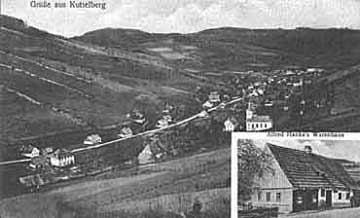
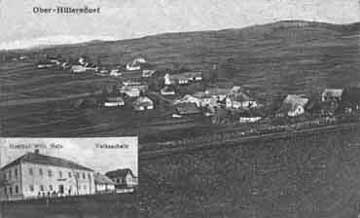
Till the second half of the 15th century, the head of the village had the title of a reeve. After becoming part of the episcopal possession, legal rules according to which the village judge could use the title reeve, changed. The office of the reeve administered territorial, hypothecary and orphan books till 1848 and was endowed with the right to brew ale from 1584. Several hides, a tavern, smithery, bakery, butchery, cooperage, two mills, iron-mill with logging privilege, several farmhouses, the right for game and fish hunting belonged to the reeve's office. The reeve paid only 49 red gold coins and 29 groschens per year from all his belongings. Traditionally, the reeve's office was not under the aristocratic tenancy.
In 1770, thirteen houses including two taverns were part of the reeve's office as well as eight workers who during haymaking and harvest had to work in the reeve's fields in exchange for something to eat and a small salary. The reeve tithed 90 golden coins and 24 dimes to the master's income and drew 84 golden coins from two taverns, 38 golden coins and 20 dimes from workers and 81 bags of flour from two mills. This unusually profitable rate for the reeve between the payment tithed to the suzerain and charges from own subjects was constantly causing disagreement among bishopric clerks. In 1784 the bishop's prosecutor accused the reeve of an unauthorized administration of lower justice over bishop's subjects. Next year the government administration started to deny the mayoralty's privilege to administer territorial, hypothecary and orphan books. Vincenc Richter, who bought the mayoralty in 1781, refused despite several summons to give these books to the authorities office residing in Zlaté Hory. He was threatened with army's assistance in case he does not obey. Finally the reeve won this case and kept the territorial books till 1884.
In the end of the 18th century, the reeve's office (evaluated at 15 000 golden coins) had two gardeners and 32 allotment holders, thus the agenda for purchases and sales was quite large. After Richter as the reeve, it was the bishop Hohenlohe who gained the office of the reeve. His inheritors sold it to eight partakers in 1897. The last owner of the office of the reeve was Josef Schöhn.
The Church and the Parsonage
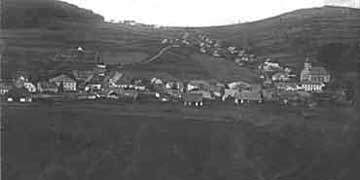

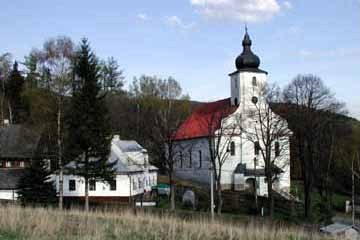
At the beginning, the village belonged to the Zlaté Hory parsonage. However, in 1579 it did not tithe the charges and a vicar complained to a visitor. In 1588 the bishop Ondřej Jerin placed order to build a stone church in Heřmanovice. Three years later, on 6th June, the bishop approved a contract between the village of Heřmanovice and the vicar of Zuckmantel (the then Zlaté Hory) Baltazar Topper. The contract allowed Töpper to provide church services each third Sunday and on holidays in this new church. Around 1638 the vicar's salary from Zlaté Hory was 36 talers, which may have included the income from Mnichov. In 1651 the vicar owned a piece of field, from which he earned 15 talers of gale and an extra bonus apart from an interest from a foundation. Sometimes before this year, the reeve Jan Biroldt placed order to build the main altar with the sculpture of Saint Ondřej and also one side altar.
The long distance from Zlaté Hory made the church authorities decide to build up an autonomous parsonage in 1672 with a school next to it. During the time of negotiations about the foundation of a parsonage, it was found that there were 6000 inhabitants and 300 people lived in the neighbouring Mnichov. These two villages guaranteed to support the vicar and the owners of bigger farm houses to pay 22-24 groschens to him. The subjects were getting used to the church administration slowly and thus it could happen that in 1674 a local vicar wondered over the fact that weddings took place together with christenings.
Forests
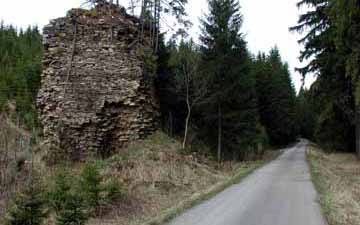
Forests represented an important part of bishop's possessions. However, since the 16th century, an intensive and often inconsiderate logging was carried out for mines, blast furnaces, iron mills, saw mills, and for inhabitants, who were poaching in forests and streams. That was the reason why bishops started to issue forest regulations since the 16th century. The forest regulation for gamekeepers in Heřmanovice (issued by bishop Ondřej Jerin in 1588 ) is a very valuable document for the history of forestry because there are only few instructions from that period. These forest instructions regulated tree logging, coal burning, it prevented cheats with salt for the game and they supported wolf hunting, which were doing damage to game and cattle. The situation in streams and small ponds was not good either.
Permanently increasing wood consumption led the bishop Martin Gerstmann to issue forest rules for the dominion of Zlaté Hory on 30th of April 1574. In one of the rules it is said that rivers, ponds and streams were fished out and should be therefore protected and fish hunting should be strictly banned with a threat of a high penalty. People from Heřmanovice and Zlaté Hory followed their cattle along pastures which stretched up to the border with Bruntál and Krnov. As they were taking their hunting dogs with them and were also hunting the big game themselves, the rule banned the game shooting and pasturing of the cattle in forests.
Between 3rd -9th of April 1743 commissaries passed through all the preserves of the dominion of Zlaté Hory and on 9th April recorded the results into a voluminous register, which stated that the main tree species of Heřmanovice forests were pine spruce, beech and fir.
Wood from local large forests was bought not only by subjects from neighbouring domains but it was also exported to the low-land Prussia's Silesia, where it was in shortage. The empress wanted to prevent this by banning the wood export, which resulted in a difficult situation for the people of Heřmanovice. The ban was later moderated.
In 1780 forests in the area between Vrbno - Mnichov - Heřmanovice - Zlaté Hory were marked out as forests in a strategic protected zone and logging in them was banned.
From 1753 till the end of the 18th century the acreage of forests in Heřmanovice was reduced almost by one fourth. This was caused by the increase in logging, by fires set up by carbonization, insufficient care for underbrush and their stumping up for new fields. There was a dry kiln for spruce seeds for episcopal forests in Heřmanovice. Work in the woods and production of wooden goods were important sources of livelihood till the 20th century.
| year | 1610 | 1647 | 1672 | 1687 | 1770 | 1805 | 1811 | 1837 | 1850 | 1869 | 1880 | 1890 | 1900 | 1910 | 1921 | 1930 | 1950 | 1961 | 1970 | 1980 | 1991 | 2001 |
|---|---|---|---|---|---|---|---|---|---|---|---|---|---|---|---|---|---|---|---|---|---|---|
| number of inhibitans | - | - | 600 | - | - | 1997 | 2034 | 2575 | 2837 | 2768 | 2663 | 2390 | 2393 | 2266 | 2101 | 2187 | 415 | 601 | 566 | 521 | 440 | 411 |
| number of houses | 66 | 60 | - | 65 | 191 | 344 | 364 | 400 | - | 411 | 441 | 457 | 455 | 455 | 457 | 462 | 364 | 143 | 134 | 121 | 105 | 105 |
